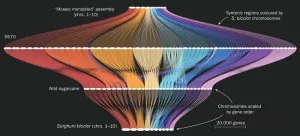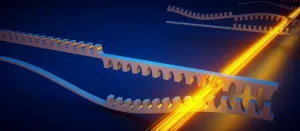(Press-News.org) SAN ANTONIO — March 27, 2024 —Southwest Research Institute is leading two groundbreaking experiments — on the ground and in the air — to collect astronomical data from the total solar eclipse that will shadow a large swath of the United States on April 8, 2024. SwRI’s Dr. Amir Caspi leads the Citizen Continental-America Telescopic Eclipse (CATE) 2024 experiment, a broad scientific outreach initiative funded by the National Science Foundation (NSF) and NASA, that will engage community participants to make a continuous 60-minute high-resolution movie during the April 8 solar eclipse. Caspi also leads an investigation that will use NASA’s WB-57F research aircraft to chase the eclipse shadow.
“Total solar eclipses are unique opportunities for scientists to study the hot atmosphere above the Sun’s visible surface,” said Caspi, principal investigator of both projects. “The faint light from the corona is usually overpowered by the intense brightness of the Sun itself. Total solar eclipses allow scientists to view the complex and dynamic outer atmosphere in ways that aren’t possible or practical by any other means, opening new windows into our understanding of the solar corona.”
CATE 2024 will use a network of 35 teams of community participants, or “citizen scientists,” representing local communities along the eclipse path, deploying a “bucket brigade” of small telescopes — from the Texas-Mexico border to Maine — following the eclipse’s shadow path. This next-generation project builds on the experience of the first Citizen CATE experiment in 2017, led by Matt Penn of the National Solar Observatory, which used 68 stations to observe the August 2017 total solar eclipse that crossed the continental United States. CATE 2024 expands the scientific objectives by measuring polarized light and engages with new teams across this year’s eclipse path.
Additionally, for the second time, Caspi leads a project to observe an eclipse with NASA’s WB-57F research aircraft. In 2017, he led the first solar observations using these aircraft, outfitted with telescopes mounted in the aircraft nose cone. In 2024, Caspi’s team will deploy a new suite of sensitive, high-speed, visible-light and infrared imagers, built by NASA’s Langley Research Center, to observe the corona during the eclipse at 50,000 feet. These high-altitude observations both provide measurements that can’t be made from the ground and avoid any weather-related risks. The WB-57F aircraft will also carry two other experiments, from the University of Hawaii and Virginia Tech, and Caspi serves as the mission scientist, coordinating between NASA and the experiment leads.
“Both projects will require an enormous effort and precise timing to get the data we need,” Caspi said. “I am honored to be part of such exceptionally talented and professional teams, and grateful for everyone’s dedication and hard work.”
Looking at complex motion in the solar corona, at new wavelengths and with new polarization measurements, will help scientists understand why it is so hot. The corona is millions of degrees Celsius, hundreds of times hotter than the visible surface below, which is a longstanding scientific mystery. The corona is also one of the major sources of eruptions that cause geomagnetic storms at Earth. These phenomena damage satellites, cause power grid blackouts and disrupt communication and GPS signals, so it’s important to better understand them.
“The airborne platforms guarantee perfect observing conditions, above any weather and more than 90 percent of Earth’s atmosphere, which can affect image quality,” said SwRI co-investigator Dr. Dan Seaton, who serves as the science lead for both projects. “Combining the airborne mobile data with the CATE 2024 hour-long string of observations will provide a more complete picture of the Sun’s mysterious corona.”
The SwRI-led airborne team includes scientists from the National Center for Atmospheric Research High Altitude Observatory, NASA Langley Research Center, and Predictive Sciences Inc., with collaborators at the Smithsonian Astrophysical Observatory. The SwRI-led CATE 2024 project, funded by NSF and NASA, includes scientists from the National Center for Atmospheric Research, the National Solar Observatory, the University of Colorado, and the Space Science Institute, with collaborators at New Mexico State University and the Livelihoods Knowledge Exchange Network, community leaders at Rice University, Indiana University Bloomington, and the University of Maine, and over 100 community participants in 35 communities along the eclipse path.
Interested parties can find more information about both projects on the group’s website: https://eclipse.boulder.swri.edu.
END
SwRI leads airborne, ground-based 2024 eclipse observation projects
Eclipse events offer unique opportunities to study the solar corona
2024-03-27
ELSE PRESS RELEASES FROM THIS DATE:
Lighting up the future
2024-03-27
New multidisciplinary research from the University of St Andrews could lead to more efficient televisions, computer screens and lighting.
Researchers at the Organic Semiconductor Centre in the School of Physics and Astronomy, and the School of Chemistry have proposed a new approach to designing efficient light-emitting materials in a paper published this week in Nature (27 March).
Light-emitting materials are used in organic light-emitting diodes (OLEDs) that are now found in the majority of mobile ...
Sweet success: researchers crack sugarcane’s complex genetic code
2024-03-27
Modern hybrid sugarcane is one of the most harvested crops on the planet, used to make products including sugar, molasses, bioethanol, and bio-based materials. It also has one of the most complex genetic blueprints.
Until now, sugarcane’s complicated genetics made it the last major crop without a complete and highly accurate genome. Scientists have developed and combined multiple techniques to successfully map out sugarcane’s genetic code. With that map, they were able to verify the specific location that provides resistance to the impactful brown rust disease ...
WISPR team images turbulence within solar transients for the first time
2024-03-27
WASHINGTON — The Wide-field Imager for Parker Solar Probe (WISPR) Science Team, led by the U.S. Naval Research Laboratory (NRL), captured the development of turbulence as a Coronal Mass Ejection (CME) interacted with the ambient solar wind in the circumsolar space. This discovery is reported in the Astrophysical Journal.
Taking advantage of its unique location inside the Sun’s atmosphere, the NRL-built WISPR telescope on NASA’s Parker Solar Probe (PSP) mission, operated by the Johns Hopkins University Applied Physics Laboratory (JHUAPL), captured in unparalleled detail the interaction between ...
Undocumented immigrants faced unique mental health challenges during COVID-19 pandemic
2024-03-27
Four years after the U.S. shut down in the face of the COVID-19 pandemic, research from Rice University suggests undocumented immigrants’ mental health challenges were compounded due to stresses stemming from their unauthorized status.
“Implications of Undocumented Status for Latinx Families During the COVID-19 Pandemic: A Call to Action” appears in the Journal of Clinical Child & Adolescent Psychology and examines how undocumented immigrants navigated the COVID-19 pandemic.
During a series of in-depth interviews with undocumented individuals or those from ...
Old immune systems revitalized in Stanford Medicine mouse study, improving vaccine response
2024-03-27
Planes, trains, boats, automobiles and even feet. During the past decades and centuries, global travel and human migration have made all of us more worldly — from our broadening awareness of the world beyond our birthplaces, to our more sophisticated palates, to our immune systems that are increasingly challenged by unfamiliar bacteria and viruses.
In the elderly, these newly imported pathogens can gain the upper hand frighteningly quickly. Unfortunately, however, vaccination in this age group isn’t as effective as it is in younger people.
Now a study conducted in mice by Stanford ...
Discovery has potential to solve the billion-dollar global cost of poorly managed wound healing
2024-03-27
Scientists have uncovered a key step in the wound healing process that becomes disabled in diseases like diabetes and ageing, contributing to a global healthcare cost of managing poorly healing wounds exceeding $250 billion a year. Importantly, the research published in Nature reveals a molecule involved in the healing of tissues that – when injected into animal models – leads to a drastic acceleration of wound closure, up to 2.5 times faster, and 1.6 times more muscle regeneration.
Lead researcher, Associate Professor Mikaël Martino, from Monash University’s Australian Regenerative Medicine Institute (ARMI) in Melbourne, Australia, said the discovery ...
Newly uncovered history of a key ocean current carries a warning on climate
2024-03-27
It carries more than 100 times as much water as all the world's rivers combined. It reaches from the ocean's surface to its bottom, and measures as much as 2,000 kilometers across. It connects the Indian, Atlantic and Pacific oceans, and plays a key role in regulating global climate. Continuously swirling around the southernmost continent, the Antarctic Circumpolar Current is by far the world's most powerful and consequential mover of water. In recent decades it has been speeding up, but scientists have been unsure whether ...
Evolution of the most powerful ocean current on Earth
2024-03-27
The Antarctic Circumpolar Current plays an important part in global overturning circulation, the exchange of heat and CO2 between the ocean and atmosphere, and the stability of Antarctica’s ice sheets. An international research team led by the Alfred Wegener Institute and the Lamont-Doherty Earth Observatory have now used sediments taken from the South Pacific to reconstruct the flow speed in the last 5.3 million years. Their data show that during glacial periods, the current slowed; during interglacials, it accelerated. Consequently, if ...
New topological metamaterial amplifies sound waves exponentially
2024-03-27
Researchers at AMOLF, in collaboration with partners from Germany, Switzerland, and Austria, have realized a new type of metamaterial through which sound waves flow in an unprecedented fashion. It provides a novel form of amplification of mechanical vibrations, which has the potential to improve sensor technology and information processing devices. This metamaterial is the first instance of a so-called ‘bosonic Kitaev chain’, which gets its special properties from its nature as a topological material. It was realized by making nanomechanical resonators interact with laser light through radiation pressure forces. The discovery, which is published on March ...
Making long-term memories requires nerve-cell damage
2024-03-27
March 27, 2024—(BRONX, NY)—Just as you can’t make an omelet without breaking eggs, scientists at Albert Einstein College of Medicine have found that you can’t make long-term memories without DNA damage and brain inflammation. Their surprising findings were published online today in the journal Nature.
“Inflammation of brain neurons is usually considered to be a bad thing, since it can lead to neurological problems such as Alzheimer’s and Parkinson’s disease,” said study leader Jelena Radulovic, M.D., Ph.D., professor in the Dominick P. Purpura Department of Neuroscience, professor of psychiatry and behavioral sciences, and the Sylvia ...
LAST 30 PRESS RELEASES:
COVID-19 leaves a lasting mark on the human brain
Scientists use ultrasound to soften and treat cancer tumors without damaging healthy tissue
Community swimming program for Black youth boosts skills, sense of belonging, study finds
Specific depressive symptoms in midlife linked to increased dementia risk
An ‘illuminating’ design sheds light on cholesterol
Who is more likely to get long COVID?
Study showcases resilience and rapid growth of “living rocks”
Naval Research Lab diver earns Office of Naval Research 2025 Sailor of the Year
New Mayo-led study establishes practical definition for rapidly progressive dementia
Fossil fuel industry’s “climate false solutions” reinforce its power and aggravate environmental injustice
Researchers reveal bias in a widely used measure of algorithm performance
Alcohol causes cancer. A study from IOCB Prague confirms damage to DNA and shows how cells defend against it
Hidden viruses in wastewater treatment may shape public health risks, study finds
Unlock the power of nature: how biomass can transform climate mitigation
Biochar reshapes hidden soil microbes that capture carbon dioxide in farmland
Reducing saturated fat intake shows mortality benefit, but only in high-risk individuals
Manta rays create mobile ecosystems, study finds
Study: Mixed results in using lipoic acid to treat progressive multiple sclerosis
Norbert Holtkamp appointed director of Fermi National Accelerator Laboratory
New agentic AI platform accelerates advanced optics design
Biologists discover neurons use physical signals — not electricity — to stabilize communication
Researchers discover that a hormone can access the brain by hitchhiking
University of Oklahoma researcher awarded funding to pursue AI-powered material design
Exploring how the visual system recovers following injury
Support for parents with infants at pediatric check-ups leads to better reading and math skills in elementary school
Kids’ behavioral health is a growing share of family health costs
Day & night: Cancer disrupts the brain’s natural rhythm
COVID-19 vaccination significantly reduces risk to pregnant women and baby
The role of vaccination in maternal and perinatal outcomes associated with COVID-19 in pregnancy
Mayo Clinic smartwatch system helps parents shorten and defuse children's severe tantrums early
[Press-News.org] SwRI leads airborne, ground-based 2024 eclipse observation projectsEclipse events offer unique opportunities to study the solar corona










